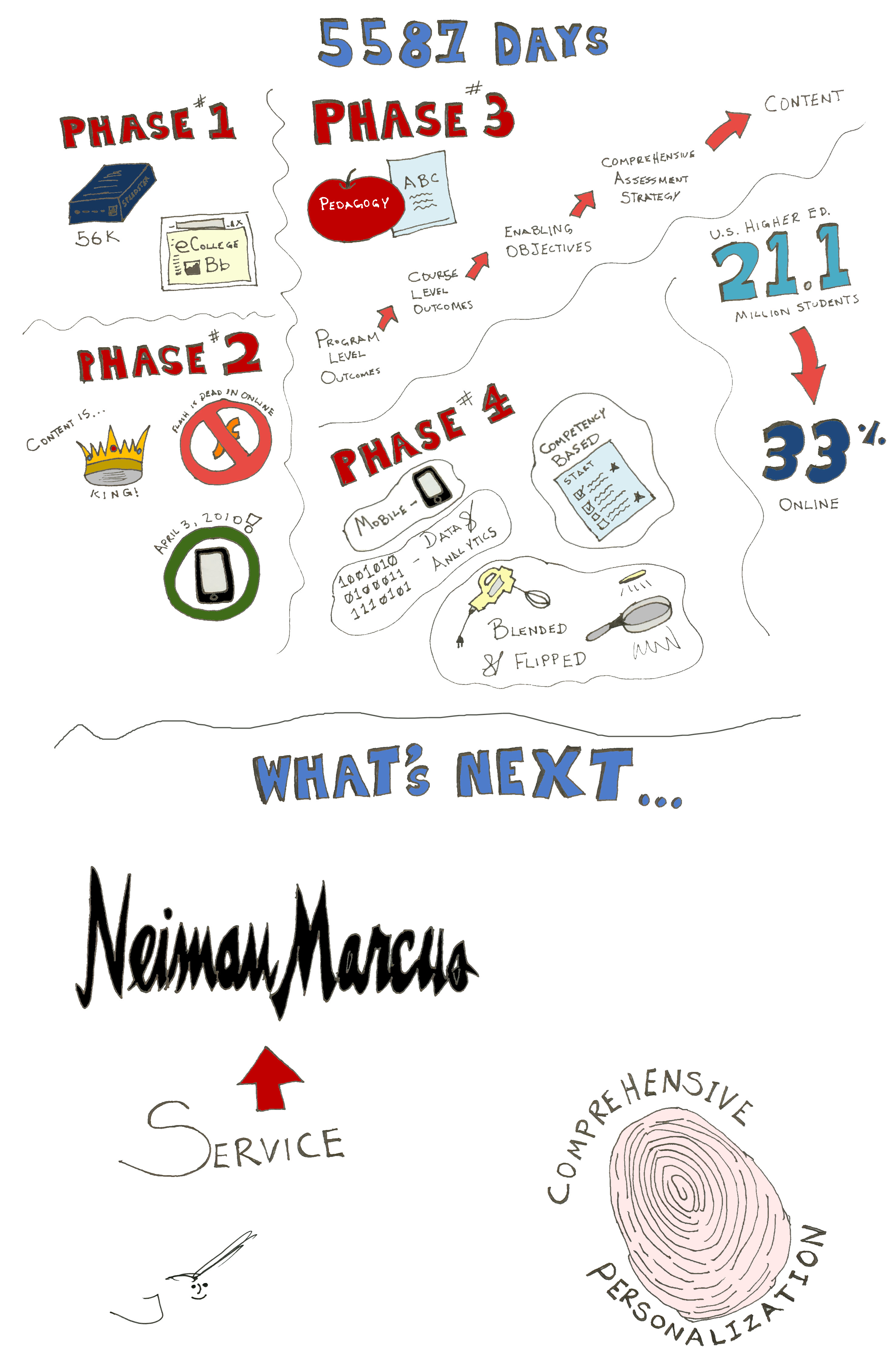5587.
5587 are the number of days that I have spent living, breathing, thinking and working on online learning. Over that time we have made remarkable progress in a space that virtually did not exist 20 years ago. Below is a brief, high-level summary of what has transpired over those 5587 days (at least how I saw it):
PHASE I
- It was all about the Learning Management System (LMS). eCollege, Blackboard, Angel, and D2L ruled the day.
- The 56 K modem was the minimum required bandwidth to deliver 'content' (text and pictures primarily).
PHASE II
- While the LMS was still a centerpiece and technologists were the primary decision makers in the online space, the phrase 'Content is King' gained momentum and academics started to get involved in the discussions - still relying heavily and deferring to the technologists.
- Training focused on the LMS and how to find and utilize external resources on the internet (no attention was given to Digital Rights Management as everything on the internet is free right?).
- 'Interactivity' became a common buzzword and Flash developers became the rock stars of the day. They hung on for a decade until April 3, 201o (remember what happened that day? Apple released the first iPad). Flash was so prolific that many said it was here to stay and Jobs would need to conform... one more example of an epic disruptive innovation.
PHASE III
- The LMS moved from the centerpiece to the background and technologists became supporters and influencers as the word 'pedagogy' became common place and academics took the reins with decision-making (and I say 'word' pedagogy as it has taken a long time to imbue pedagogical and analogical models into online learning... and we still have a lot of work to do here).
- Broadband became more widely available (while it seems like broadband has been ubiquitous for some time, it is still a relatively recent phenomenon. Only five short years ago I testified to the FCC on 'the rapidly emerging digital landscape and the future of online learning, enabled by ubiquitous broadband.' If you have three hours to kill you can watch it here).
- Instructional Designers started to have a larger voice as they could marry pedagogy and technology in a way that made learning easier for students.
- Third-party providers like Quality Matters and the American Council on Education began to focus on providing evaluations of courseware and programs.
- The shift from 'content' to 'courseware' made huge differences in what type of learners could actually learn online. The program-level approach to design of starting with program-level outcomes, then moving to course level outcomes, defining and designing enabling objectives, developing aligned multiple forms of assessments topped off with a culminating program level capstone assessment and THEN creating the content - may be one of the biggest improvements we have seen in the past 20 years. The focus had shifted from technology to teaching and learning.
PHASE IV (Current)
- Our current phase includes adaptive technologies, ubiquitous and extensible design (for mobile and quick-twitch learning), data & analytics, and new approaches that include Competency-Based Education (CBE), Blended, and Flipped instructional models. We have moved into an optimization phase for online learning. With 33% of the 21.1 M US Higher Education students now taking some of their coursework online, many say that online learning has gone mainstream.
WHAT'S NEXT?
While there is an online learning spectrum, consisting of schools that are just getting started on the left, spanning to those that are optomizing online learning on the right, one thing is clear - there is now a pretty comprehensive blueprint for what works and what does not. It is no longer about access (something we have all talked about for many years). Many schools, programs, and providers are focusing Continuous Quality Improvement (CQI) of the system but the epic gains are going to come from an entirely new area - comprehensive personalization and 'customer' service (for the student).
Students are no longer bound by geographies. They have a massive amount of information available to them on the schools and programs they are looking at, they know the probability of gaining employment in the field for which the degree is training them for, they know how much they will earn when they graduate and they know what options are available to them 'in the marketplace' (it may be earth-shattering to some to think of higher education as a 'marketplace' but it is where we are today) . Students are making one of the largest investments of their lives and they are becoming very savvy consumers. Prior to application, they are beginning to ask more and more questions about services, supports, and flexibility... and are making these elements key to their selection criteria.
The question is, are schools prepared to invest the same level of effort in services as they do on instruction and curriculum? More on what those models will look like in a future post but one thing is for sure, comprehensive personalization and services will be the next big wave in US Higher Education Online Learning.
